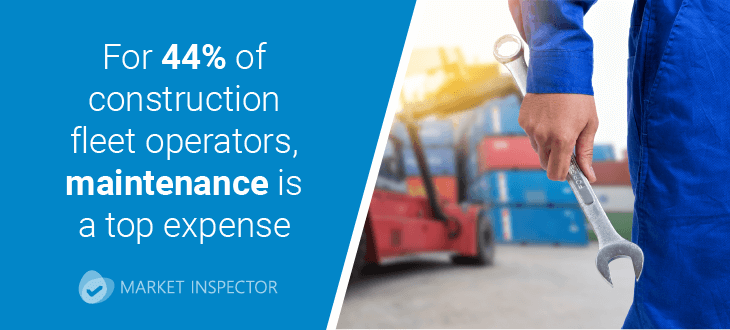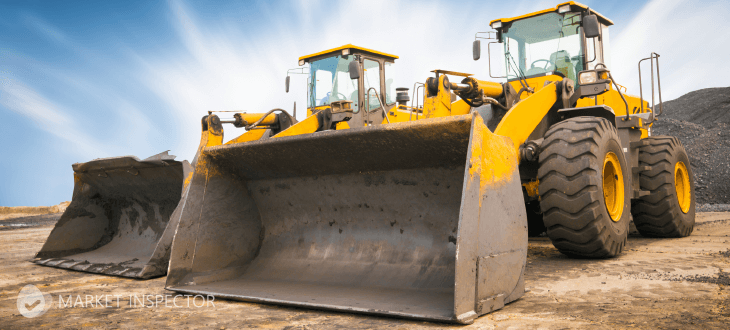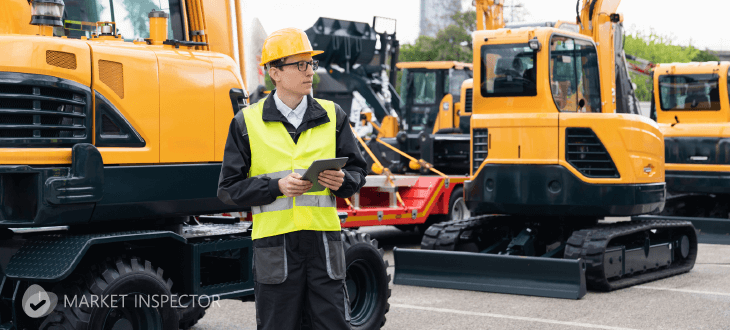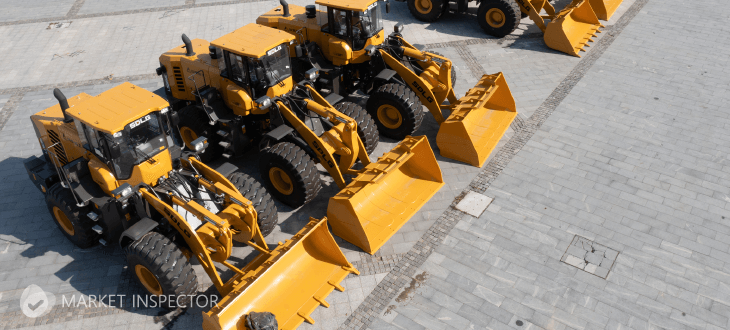Answer these simple questions and we will find you the BEST prices
Which type of solar quotes do you need?
It only takes 30 seconds
100% free with no obligation

Get up to 4 quotes from our selected suppliers by filling in only 1 form

Save money by comparing quotes and choosing the most competitive offer

Our service is 100% free and with no obligation
- Market-Inspector.co.uk
- Vehicle Tracking
- Construction equipment tracking
Why and How Should You Track Your Construction Equipment?


- For construction companies, the strategic installation of tracking devices prevents theft and contributes to better fleet management, reduced downtime, and greater compliance with safety and operational standards.
- Vehicle and equipment maintenance is a significant expense across construction fleets, with 44% of operators saying it was one of their largest costs.
Tracking systems for construction equipment offer real-time location information and valuable insights to enhance fleet management in the UK. These systems allow you to oversee equipment utilisation, deter misuse, and plan maintenance to maximise efficiency and extend equipment lifespan. This approach reduces costs, safeguards your employees, and ensures your projects proceed smoothly.
- Describe your needs
- Get free quotes
- Choose the best offer
It only takes 30 seconds

Plant tracking against theft
Tracking your construction equipment is crucial, particularly regarding safeguarding against theft. Any business dealing with plant and machinery, whether owned or rented, must consider this concern. Anti-theft tracking systems are not merely an operational tool but a critical investment in security.
This is according to GoCodes, an industry leader in tool tracking. The company highlights the ability to track systems to monitor equipment in real-time, create virtual boundaries, act as a theft deterrent, and assist in recovering stolen assets.
Construction machinery is particularly vulnerable to theft due to its high value and the ease with which it can be resold. Criminals often target these machines due to their significant resale value and the relatively low risk of being caught, especially if the equipment lacks a tracking system.
Statistics from Allianz showcase the risk. For instance, in England, tools worth £17.5 million (approximately $22 million) were stolen just in London. These figures show that construction equipment theft continues to be profitable for thieves, with recovery rates significantly lower than those for stolen cars due to the absence of universal registration systems.
It can be highly beneficial to have an insurance-approved vehicle tracker. Insurers often offer reduced premiums for low-risk equipment, including machinery fitted with anti-theft devices.
Furthermore, if equipment is stolen, recovery is more feasible if tracked, potentially lowering overall insurance claim costs. Tracking systems deter theft and provide critical data that can aid in quickly recovering stolen items, ultimately keeping insurance claims and premiums more manageable for business owners.
Equipment tracker: anti-theft features

Integrating equipment trackers with advanced anti-theft features in the fast-paced construction industry is vital for protecting valuable machinery and ensuring efficient project management. This is according to Frenter, a company specialising in the heavy equipment industry. This information comes from their guide on efficiently tracking equipment with GPS and anti-theft technology.
GPS tracking devices for construction equipment provide real-time location data, a powerful deterrent against theft. This technology enables construction companies to monitor equipment continuously and receive alerts for unauthorised movement, which helps prevent potential thefts.
Geofencing
Geofencing adds another layer of security by creating virtual boundaries around predefined areas.
If plant and machinery trackers detect any equipment moving outside these geofenced zones, immediate alerts are triggered. This feature is critical for maintaining tight security and preventing equipment from being transferred to unauthorised locations.
Anti-tampering solutions
Anti-tampering measures, including sensors and alarms integrated into the equipment, play a crucial role in enhancing security.
These measures ensure that unauthorised access or tampering attempts are immediately detected and reported, allowing quick actions to secure the equipment.
Combining anti-theft solutions
The combination of GPS tracking, geofencing, and anti-tampering technologies offers comprehensive benefits. Enhanced security through real-time monitoring and immediate alerts significantly reduces the theft risk.
Monitoring equipment usage and optimising resource allocation improves productivity and saves costs by preventing theft and reducing downtime. Detailed insights into equipment location and status facilitate efficient workflow management, enabling better planning and logistics execution.
Adopting commercial vehicle tracking systems enhances operational oversight and provides real-time asset locations. Advanced tracking solutions, such as wireless GPS tracking for construction equipment and heavy equipment, are becoming essential in the construction industry.
Technologies such as digger trackers, mini digger trackers, and tractor trackers protect assets and ensure optimal utilisation and operational efficiency, underscoring the importance of these systems in contemporary construction management.
Real-time monitoring with equipment tracking devices

In an industry as demanding as construction, where precision and efficiency directly impact profitability, real-time equipment monitoring through tracking devices offers significant advantages.
For UK-based construction business owners, this technology is not just about location tracking; it's a strategic tool that optimises the use of the construction equipment fleet and ensures each asset's most effective deployment.
Real-time monitoring allows for the continuous tracking of equipment, providing updates on its location, operation, and even the health of the machinery in real-time.
This level of visibility helps make informed decisions quickly, reduces downtime, and enhances the fleet's productivity. Moreover, it assists in forensic-level management, giving owners a clear picture of how equipment is used, which can lead to improved operational strategies and reduced operational costs.
Plant tracker: Data and usage insights features
Modern tracking systems have various features that serve beyond mere location tracking. These features provide deep insights into equipment usage and maintenance needs, which are crucial for optimising operations and extending the lifespan of valuable assets. This is according to Teletrac Navman’s research on Telematics for construction.
- Geofencing: This feature alerts when equipment enters or exits predefined geographical boundaries. It's invaluable for ensuring equipment is only used where it’s supposed to be, enhancing security and operational compliance.
- Usage reporting: Trackers can report on hours of operation, which is particularly useful for off-road assets. This data helps identify underutilised equipment that can be reallocated, thus maximising the fleet's efficiency.
- Maintenance alerts: By monitoring parameters like engine hours, fuel consumption, and mechanical health, tracking devices can prompt timely maintenance checks. This proactive approach prevents breakdowns, minimises downtime, and extends the equipment’s operational lifespan.
- Driver behaviour monitoring: For on-road vehicles, trackers provide insights into driver behaviour, which can highlight areas where training is needed to improve safety and efficiency.
- Enhanced route planning: By analysing real-time traffic data and site requirements, tracking devices help plan the most efficient routes, saving time and reducing fuel consumption.
For business owners in the construction sector, investing in advanced tracking technologies means gaining a competitive edge. The detailed data and insights these systems offer improve day-to-day operations and contribute to long-term business growth by ensuring that every piece of equipment delivers its maximum potential.
This strategic approach to fleet management saves costs and improves service delivery to clients, enhancing overall business reputation.
Installing trackers for plant machinery

Installing tracking devices on plant machinery is a crucial step for construction business owners to secure their assets and improve equipment management.
Here’s how to effectively implement trackers across various types of construction machinery, such as tractors, diggers, bulldozers, and generators, catering to the needs of UK-based business owners. This is based on insights from Geo-fencing for Site Security and Theft Prevention, a guide from Frenter.
Types of trackers and equipment
Different construction equipment requires other types of trackers based on the machinery's size, usage, and susceptibility to theft. For example:
- Tractors and bulldozers: These large vehicles benefit from robust GPS trackers that can monitor location and operational data like fuel usage and working hours.
- Diggers and mini diggers: Compact trackers that are hard to detect and disable are ideal, as these machines are often targets for theft on construction sites.
- Generators and other portable equipment: Wireless, battery-operated trackers can be used, as these items might be moved frequently across and between sites.
Installation Process
According to Teletrac Navman, the tracker fitting process generally involves:
- Selecting the appropriate tracker: A suitable tracker that can withstand environmental conditions and potential tampering is chosen depending on the equipment type.
- Positioning the tracker: Trackers should be installed in concealed areas within the machinery to prevent thieves from quickly accessing them. The location should be discreet yet accessible for maintenance.
- Integration with telematics software: Connecting the tracker to fleet management software enables data transmission to a central system, which provides real-time insights into machinery usage and location.
Preventing tampering
To prevent tampering and ensure the longevity of the trackers, installation should consider the following:
- Secure enclosures: Trackers should be housed in safe, locked enclosures that are integrated into the machinery’s frame, making removal difficult without significant effort or damage.
- Alert systems for tampering: Advanced trackers come with tamper alerts that notify managers if any unauthorised attempt to remove or disrupt the tracker occurs.
Best plant and machinery trackers
When selecting the best trackers for plants and machinery, it's important to consider factors such as the features offered, reliability, user interface, and cost-effectiveness.
Here is a breakdown of some of the most notable brands and companies that provide trackers for construction equipment, along with a comparison of their strengths and weaknesses.
Teletrac Navman
Strengths
- Robust reporting features: Offers comprehensive compliance and logistics management tools, ideal for adhering to UK regulations.
- Scalability: Its flexible solutions are suitable for any business size, supporting growth without losing functionality.
Weaknesses
- Complexity: The system's rich features can be complex, necessitating a steep learning curve during setup and training.
- Subscription fees: The ongoing cost can impact long-term budgeting, requiring continuous investment.
ABAX
Strengths
- Strong UK presence: Provides dedicated support and solutions specifically tailored for the UK market.
- Ease of use: User-friendly devices ensure accessibility across all staff levels, promoting widespread adoption.
Weaknesses
- Integration issues: Potential challenges in integrating the system with existing business software could complicate operations.
- Initial setup: Setup may require more time and technical knowledge, which could delay initial deployment.
Geotab
Strengths
- High customisability: Offers bespoke solutions to meet specific business needs across diverse UK operations.
- Environmental reporting: Advanced environmental compliance features align well with UK sustainability standards.
Weaknesses
- Cost: The cost for advanced features and customisation can be high, making it a significant investment.
- Data overload: The extensive data provided can be overwhelming without proper training or adequate staff resources.
Trackunit
Strengths
- Comprehensive analytics: Provides detailed insights and predictive analytics, crucial for maintenance and operation optimisation.
- User-friendly interface: An intuitive dashboard enhances user experience, easing daily operations.
Weaknesses
- Cost: Pricing may be prohibitive for smaller businesses looking for cost-effective solutions.
- Network dependency: Dependence on cellular data could limit functionality in remote or poorly serviced areas.
Quartix
Strengths
- Real-time tracking: Immediate updates on vehicle and equipment locations enhance security and operational efficiency.
- Simple installation: The system is easy to install with minimal disruption, allowing for quick setup and integration.
Weaknesses
- Limited advanced features: May lack some of the more sophisticated analytics available from competitors, which could limit deeper insights.
- Customer service: There have been some reports of customer service needing improvement, which could affect user satisfaction.
These companies offer various solutions catering to different needs and budgets. When choosing a tracker for construction equipment, consider the specific requirements of your fleet, including the size of the fleet, typical operation areas, and the particular security or management features you need
Each brand has unique advantages and potential drawbacks, making it crucial to align their offerings with your operational priorities and constraints.
Compare multiple quotes
For UK-based business owners managing construction equipment, selecting the right tracking system is crucial for enhancing security and operational efficiency. Knowing how much a tracker costs can help justify why tracking your construction equipment is essential for improved productivity and security.
To make an informed decision and potentially reduce costs, comparing multiple tracking solutions and obtaining quotes from different providers is wise. This approach lets you identify the most cost-effective solution, tailor the system to your needs, and leverage competitive pricing.
Comparing options helps find the right fit and keeps you ahead in a rapidly evolving industry. Don't miss the opportunity to secure and optimise your fleet management. Start comparing today and streamline your operations efficiently!
- Describe your needs
- Get free quotes
- Choose the best offer
It only takes 30 seconds

FAQ
In the UK, GPS trackers are crucial for business owners in industries like construction and agriculture. These devices help prevent theft by enabling quick recovery of stolen machinery, potentially lowering insurance premiums due to reduced risks.
Trackers also improve operational efficiency by providing data on equipment usage, aiding in job scheduling and maintenance. This can extend machinery lifespan and ensure compliance with safety regulations, optimising resource management and project efficiency.
To install or find a GPS tracker on a digger, select a discreet location, like under the cab or inside a secure engine compartment, to prevent tampering. Ensure the tracker is securely mounted and check its functionality to confirm accurate location reporting.
If locating an existing tracker, inspect typical installation spots and check the owner’s manual or contact the digger’s supplier for information about any pre-installed trackers. These steps help maintain the effectiveness and security of the tracking system.

Nicole Bea Kerr is a content writer for Market Inspector, leveraging her experience in B2B journalism and editing. She is interested in bringing more awareness to sustainability and helping businesses make informed choices through insightful narratives.
We strive to connect our customers with the right product and supplier. Would you like to be part of Market Inspector?

